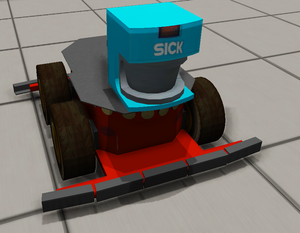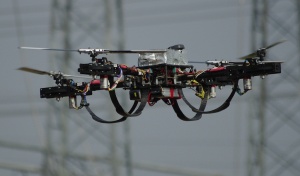[Edit query]| Show embed codeHide embed code
To embed this query inline into a wiki page use the code below.
Wiki Page: Self calibration of multiple odometric sensors 
Title: Self calibration of multiple odometric sensors mounted on the same platform
Description: An odometric sensor measures the path followed by a robot in an incremental way (e.g., wheel mounted encoders, visual odometry, scan matching based odometry, etc.) . Having several odometry sensors mounted on the same platform can significantly improve the accuracy and robustness of the overall system but requires proper calibration of relative positioning and possible biases. We are interested in the development of techniques for the self calibration of a multi sensor based odometry sensor. These techniques could be inspired by classical non-linear optimization techniques used in the hand and eye problem but they could use techniques from Simultaneous Localization and Mapping. According to the setup, some information on the real position of the system may exists (i.e., external tracking system or GPS); the approach should be able to use this information as well.
Material:
- datasets with real data
- a few odometric system implementations
- C++ libraries for non linear optimization
Expected outcome:
- software for the self calibration of a set of odometry systems mounted on the same robot
Required skills or skills to be acquired:
- C++ programming under Linux
Tutor: MatteoMatteucci, SimoneCeriani, DavideCucci
Additional Info: CFU 20 - 20 / Master of Science / Thesis
|
Wiki Page: Simulation in robotics using UDK USARSIM
Title: Simulation_in_robotics_using_UDK_USARSIM
Description: USARSim (Unified System for Automation and Robot Simulation) is a high-fidelity simulation of robots and environments based on UDK (Unreal Development Kit), the free edition of the Unreal Engine 3 game engine. It is intended as a research tool and is the basis for the RoboCup Rescue Virtual Robot Competition.
The proposed project is aimed at extending USARSim along two directions:
- Development of a tool for automatically generating realistic 3D worlds for robot testing. This task involves work on 3D game modelling and development using the UDK engine.
- Create test arenas and perform experiment in USARSim. Simulation tools as USARSim are powerful tools for robotics, but in order to consider the results obtained in a virtual environment also valid in the real case, simulated environments must be validated through experiments performed both in virtually and with real robots.
Results will be included in the USARSim project and used by the RoboCup community.
Tutor: FrancescoAmigoni, MatteoLuperto, AlbertoQuattriniLi
Additional Info: CFU 10 - 20 / Master of Science / Thesis
|
Wiki Page: Soccer Robots
Title: Soccer Robots
Description: Projects are available in different areas:
- Implementation of mechanical and electronical parts of the robots for the management of the ball and kicking
- Design of robot behaviors (fuzzy systems)
- Coordination of robots
- New sensors
These projects allow to experiment with real mobile robots. Participation to the championships is a unique experience (2000 people, with 800 robots playing all sort of games...)
The project can be turned into a thesis by facing different problems in depth.
Tutor: MarcelloRestelli
Additional Info: CFU 5 - 20 / Bachelor of Science, Master of Science / Course, Thesis
|
Wiki Page: Stability and motion control of a balancing robot
Title: Stability and motion control of a balancing robot
Description: This project is focused on the control of both stability and motion of TiltOne, a balancing robot.
TiltOne is a robot with only two wheels that can stand in vertical position following an unstable equilibrium point. The control is applied by commanding an amount of torque to the wheels, allowing the robot to mantain it's gravity center vertical aligned to the wheel axis.
The aim of the project proposal is to implement and compare different control solutions, based on classical approach (as PID and LQR control) and Machine Learning approach (as Reinforcement Learning control policies), that allow the robot to move following a given trajectory at a given speed.
Tutor: AndreaBonarini, MartinoMigliavacca
Additional Info: CFU 5 - 20 / Master of Science / Course, Thesis
|
Wiki Page: Unmanned Aerial Vehicles Visual Navigation
Title: A critical review on the state of the art in visual navigation for unmanned aerial vehicles
Description: Visual navigation is becoming more and more important in the development of unmanned aerial vehicles (UAV). The goal of this thesis/tesina is to review in a structured way the current state of art in the field from different perspective: research teams, projects, platforms, tasks, algorithms. The latter is the most important aspect obviously and the project should provide a clear view on what is done today, and obtaining which results. Two kind of operations are of most interest: tracking of fixed and mobile targets (and how this impact on the UAV path), navigation on a geo-referenced map. Implementing one of the standard approaches on a mini unmanned aerial vehicle would be the ideal ending of the work to turn it into a thesis.
Material:
- papers from major journals and conferences
- reports from research projects
Expected outcome:
- a report with a detailed review of the state of the art organized according to the main relevant aspects (to be identified during the work)
- an implementation of some state of the art algorithms for tracking or navigation
Required skills or skills to be acquired:
- proficiency in english
- basic understanding of computer vision
- basic understanding of filtering techniques
Tutor: MatteoMatteucci
Additional Info: CFU 10 - 20 / Bachelor of Science, Master of Science / Thesis
|




